This post contains affiliate links which means some I might earn a small commission if you purchase something after clicking. This NEVER impacts my recommendation — I only recommend what I personally use and believe in myself. If I’m linking to it anyway and an affiliate link is available, I use it to help support this ad-free site.
I used to scoff at people who bought organic foods or products. “I have a perfectly functional liver and kidneys” I would say.
The fact is, the human detox organs evolved over millennia in nature. They are absolutely not prepared to deal with the onslaught of chemicals we expose ourselves to daily through
- processed food and additives
- conventional produce sprayed with chemicals or genetically modified to be poison
- household cleaners
- hair and skin care products laden with perfumes, more chemicals, and micro-plastics
- water treated with chlorine and other chemicals pumped through miles of pipe
- air pollution
- so much more
Maybe they can. Maybe our detox organs can just barely manage to remove these harmful substances from our body in the course of every day life when all is otherwise well. Throw something like cancer or chemo into the mix, though, and you need those detox organs 100% focused on processing that kind of poison and your immune system 100% focused on eliminating the cancer cells.
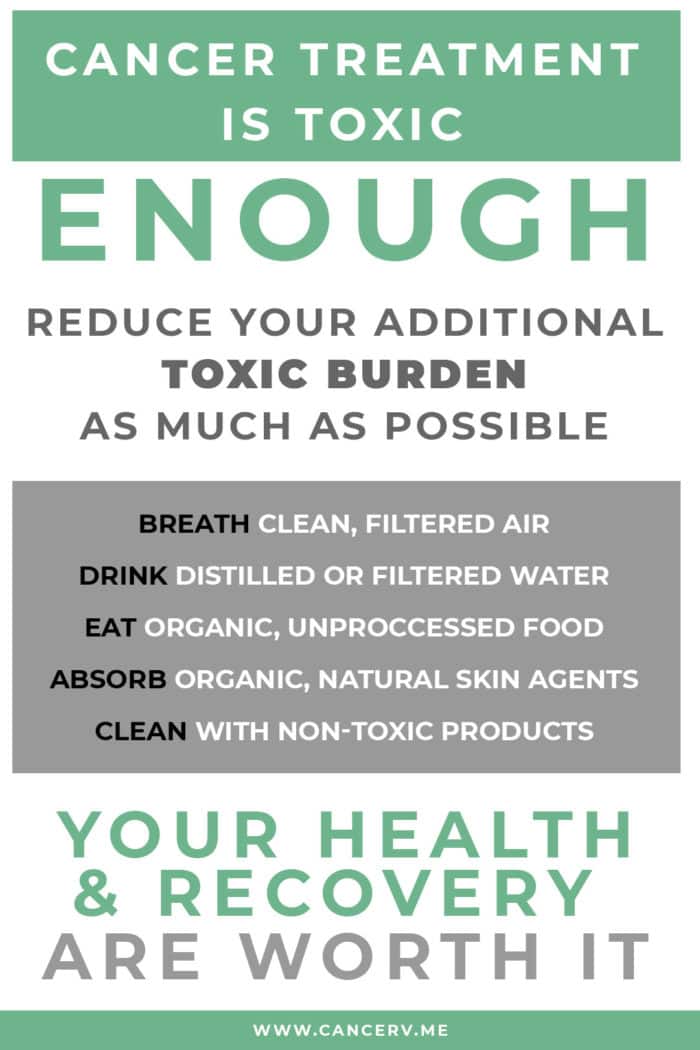
What is Toxic Load and Toxic Overload?
Toxic load or toxic burden refers to the toxins and harmful chemicals that accumulate in the body through exposure to contaminants in our food, air, personal products, household cleaners and environment. Our bodies are designed to process these types of assaults and eliminate them, along with naturally produced toxins, through our sweat, tears, exhale, feces, and urine. While the body is pretty darn incredible at doing this, it can be overwhelmed by the sheer amount of contaminants in what’s called toxic overload.
In cases of toxic overload, toxins build up within your body generating free radicals and potentially causing damage to your liver, kidneys, or other organs. Anyone who’s had a friend get alcohol poisoning knows what I mean. Sometimes “perfectly functional liver and kidneys” just aren’t enough.
Additionally, toxic overload can weaken the immune system, the very last thing anyone fighting cancer or other serious illness wants to do. It can also cause allergies and digestive sensitivities like Irritable Bowel or food intolerance.
Detoxifying for Cancer
I used to think my liver and kidneys were my only detox organs as they filter poison out of my blood and push it out of my body. I realize now that an awful lot of waste leaves through the lungs, intestine (duh) and skin. In fact, when you lose weight by burning fat, the byproducts of that fat burning, the weight you lose, leave the body through your breath and urine.
In fact, my whole view of “detoxification” changed when I was diagnosed and I really stepped back to consider how much I subjected my body to on a regular basis. Over the first months of my disease, I expanded my focus. I knew I couldn’t instantly transform into Gwenyth Paltrow but I made a commitment to do what I could with what I had, focusing on the areas that would make the biggest impact first.
I don’t believe that any of these individual steps was the key to my healing a la “Oh my god! Switching to organic shampoo cured my cancer!” I do, however, believe that my new, non-toxic way of living takes the load off my still-overworked detox organs so they can focus on processing the many drugs I take and the rest of the outside world.
These are the areas I addressed in my personal priority order. Click each to jump straight to that section.
- Air I breath
- Water I drink
- Food I eat
- Hygiene products I put on my skin
- Home products I use in my house
- Plus other unexpected sources
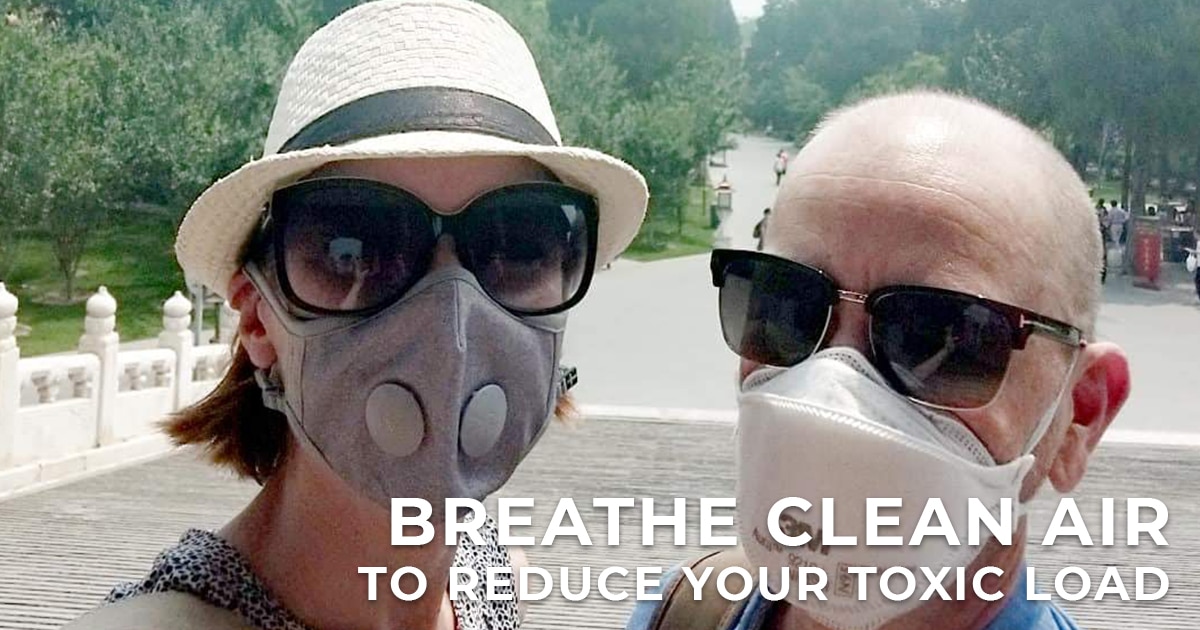
Detoxify the air you breath to reduce your toxic burden
When I was first diagnosed with lung cancer, the need for clean, breathable air was evident – I could barely breathe as it was. My blood oxygen levels were in the 80s (now 99% -100%) and I couldn’t even lay on my back because of the chest rattle and violent, painful coughing.
Within a few days of my diagnosis, Brad had done the research and ordered an air purifier. Admittedly it wasn’t the top-of-the-line $,1000+ model some folks recommended, but it’s been everything I need this past year and a half. If you’ve seen our tiny Hong Kong apartment – and you haven’t because it’s too small for guests – you know it’s high praise to say this bad boy has more than earned it’s footprint.
What’s right for you may vary but spend some time thinking about the quality of your air. In priority order, I’d recommend:
- Don’t smoke. Needless to say, if you smoke, you must stop. This topic is too large to address here but if you smoke, quitting should be your highest priority.
- Invest in an air purifier. At least your home will be your clean air sanctuary.
- Avoid fumes, exhaust, tear gas, etc. I’ve declined to ride in taxis if the driver is smoking and walked the long way home to avoid more congested streets. I had a few challenges avoiding tear gas during the Hong Kong protests but made it through with lungs stronger than ever.
- Wear a mask on poor air quality days. I keep the reusable mask in my work backpack for days when the air quality doesn’t meet muster. I use this site to monitor air quality and, when numbers in my area start to creep above 75, feel zero embarrassment pulling out the mask.
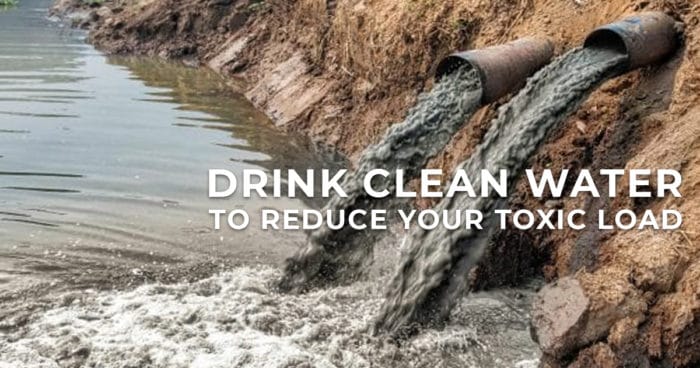
Avoid toxins in your water
As part of your detoxification, you should be drinking lots of water. Lots and lots and then some more.
As with all things, do what you can with what you have. I’d love to have time to distill all my own water and store it in bottles made from glass I blew myself from organic sand hand-harvested by celibate monks from the ancient beaches of Nepal. In real life, I spent months just getting bottles from the corner store while we tried to figure out how to install an osmosis filter in our apartment. We now have 5-gallon jugs of distilled water delivered weekly.
Drink distilled, reverse-osmosis filtered or natural spring water.
My preference is distilled because I’m suspect of mineral sources and spring sources so close to my home in China. If you go my route, make sure you supplement with trace minerals and use plenty of high-quality Himalayan pink salt or grey Celtic sea salt.
Container matters.
It took me too long to find the right light-weight, metal thermos to transport my clean water (wide mouth for personal preference, no straw lid because you don’t want to drink hot liquids through plastic). For way too long I was using plastic bottles. If, like me, you must use plastic, a general rule of thumb is that the thicker and less pliable the plastic, the less likely to release toxins into your water. And never ever put hot liquids in plastic.
Provenance matters.
Local is better for the environment but use your judgement about what’s best for your health. I never thought I’d buy something with the carbon footprint of Vox or Perrier until I found myself in China where the available local water had strong notes of grape-flavored gasoline.
Don’t worry, I didn’t make that a habit and now travel with my this portable water filter and bring or buy a more quality filter pitcher when we’re staying an extended period of time. For example, we’re using this alkalizing water filter pitcher for our three months in London and love it.
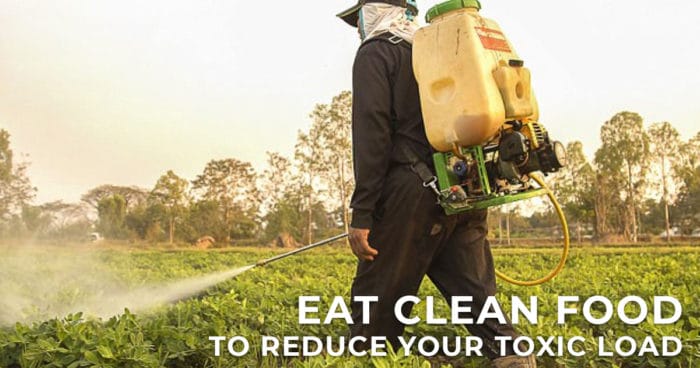
Eat clean, natural food to reduce your toxic load
This is pretty much the main subject of the rest of this website so I’ll skip the dietary preaching and try to stick to dietary principles that will reduce your toxic burden.
Nothing processed.
In my opinion, this is the most important, impactful thing you can do for your health: don’t eat processed foods. If it has more than three ingredients, do not by it. Really, if it has ingredients, you shouldn’t need to buy it but I understand that sometimes we don’t have time to make our own organic raw sauerkraut.
An ideal diet relies on organic vegetables supplemented with nuts, seeds, fruit, pastured eggs and wild-caught fish and game. In our modern times, however, it can be hard even to get these without processing. Unless you live with a tribe in the Amazon or a farming commune, it’s probably impossible to avoid processed foods completely, but there is a spectrum and you can at least be on the “better” end of that spectrum.
In that ideal world we’d only eat organic vegetables and fruits from our garden or the local farm, nut butters and flours we ground ourselves, eggs from our backyard chicken, and fish we caught while fishing the clean, cold, unpolluted rivers of utopia. In reality, we’re shopping at the grocery and there are tricks everywhere. Even those baby carrots and bagged salad greens have been in a factory and likely triple washed with chlorine and other chemicals.
Then there are the sneaky additives. How many ingredients are in the peanut butter? The only ingredient should be peanuts, maybe salt, maaaaaaaaaaaaaaaaaaaaaaaaaybbbeeee peanut oil but really just peanuts and salt. It’s ridiculously hard to find coconut milk that only contains coconuts – companies are desperate to add stabilizers, preservatives and, at very worst, sugar. I almost got tricked just this week by a bag of “Pure Acai” frozen acai pulp. It took a solid 5 minutes hunting around the packaging and squinting at the tiny ingredients to see that it did indeed have sugar as the second of way too many ingredients. Pure fruit should not need ingredients.
So, on the spectrum of processed, never settle for sugar or other additives and otherwise do the best you can.
Organic whenever possible.
Conventional produce has been sprayed with poison intended to kill living things or genetically modified to kill living things. Granted, those living things are pests like mold and bugs; farmers can usually rely on the human detox system to process them out. Since we’re trying to reduce the load on our detox systems for maximum immune support, however, it makes sense to avoid those poisons.
It’s not always possible to get organic whether for financial or availability reasons. Do the best you can with what you have. The Environmental Working Group publishes an annual list of “Clean 15” and “Dirty Dozen” produce based on US Department of agriculture data pesticide data. The “clean 15” lists fruits and vegetables that generally have the least pesticide residue when they come to market and usually includes avocados, broccoli, califlower and cabbage. The “dirty dozen” are foods that contain the most pesticide residue. Almost every year spinach and strawberries top the list with kale, tomatoes, and other thin-skinned fruits right behind. When prioritizing organic produce, use this as your guide and buy organic versions of the dirty dozen while having less concern about picking up conventional versions of the clean 15.
2020 Dirty Dozen
highest concentration of pesticides
BUY ORGANIC
- Strawberries
- Spinach
- Kale
- Nectarines
- Apples
- Grapes
- Peaches
- Cherries
- Pears
- Tomatoes
- Celery
- Potatoes
2020 Clean 15
lowest concentration of pesticides
- Avocados
- Sweet corn
- Pineapple
- Onions
- Papaya
- Sweet peas (frozen)
- Eggplants
- Asparagus
- Cauliflower
- Cantaloupes
- Broccoli
- Mushrooms
- Cabbage
- Honeydew melon
- Kiwi
Provenance matters
It’s worth knowing what country your food comes from. Different nations have different regulatory environments and allow different chemicals to be used in food production. Know where your food comes from and what the laws are like there especially with regards to labeling. “Free range” in New Zealand is different from the US. “Free range” in the US deserves its own post. Let it suffice to say, we buy organic pastured eggs from the US or organic free range from a fruit plantation in New Zealand.
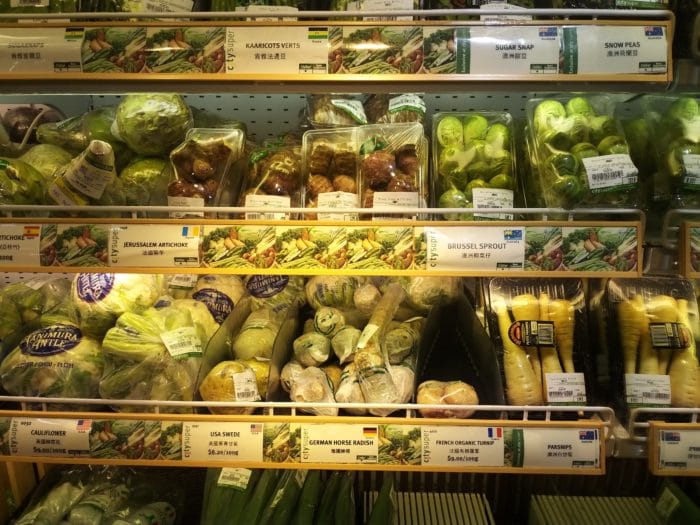
Be at least as cautious with your meat as your produce. Animals from factory farms eat not only non-organic feed, it’s feed completely unlike their natural diet and laced with antibiotics, hormones, and other chemicals that are toxic to your body. Even “grass-raised” cows were likely sent to a feed lot for the final weeks of life before slaughter. “Grass raised and grass finished” is the best compromise – although wild-caught game or no mammal as food would be ideal.
Prioritize wisely
A “perfect” or perfectly non-toxic diet is pretty much impossible in today’s world so do your best with what you have. When you make food choices, consider the toxic burden you’re adding to your already stressed detox and immune functions. From packaging (BPA-lined cans, off-gassing plastics) to provenance, there are considerations even beyond the content of food. But above all, no sugar or processed food 😉
Oh! And when you get home, don’t throw this nourishing, healing food onto a teflon nonstick pan. The fumes from overheating teflon can be deadly and the chips from any scratches just as toxic. While the industry may brag that they’ve been PFOA-free since 2013, don’t risk it. “Our pans probably haven’t killed anyone in seven years” is not the reassurance I’m looking for. I threw all my nonstick cookware in the trash and strongly recommend you do the same.
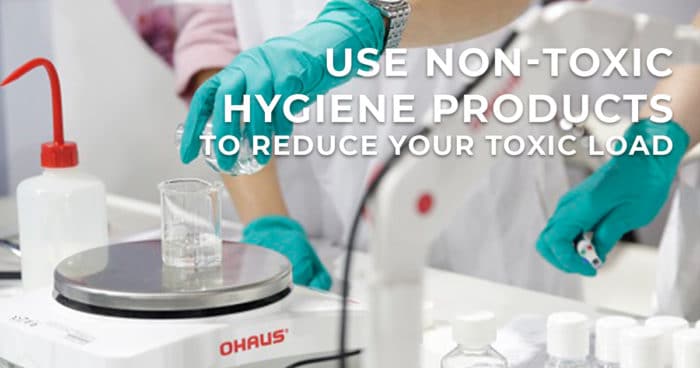
Reduce the toxic burden of your cosmetic and hygiene products
Toiletries and personal care products is really an area where you need to follow the 80/20 rule. It’s incredibly difficult to go cold turkey on toxic chemicals here so try to get the most coverage you can. For example, something like body lotion that is absorbed into the majority of your skin should be a high priority to detoxify. A conditioner that only comes in contact with your hair and isn’t intentionally absorbed into the skin is probably lower priority. Of course, I could have just made this up because I’m too vain to give up mascara.
It is incredibly difficult to find reliable information about product toxicity online. My rule of thumb is not to put anything on my skin that I wouldn’t eat.
Ingredients I avoid include (but are in no way limited to):
- Butylated hydroxytoluene (BHT) This synthetic antioxidant is used to extend product shelf life but is a strongly suspected carcinogen and hormone disruptor.
- Formaldehyde A known carcinogen and neurotoxin that has been linked to asthma and developmental toxicity. Good for embalming the dead, though.
- Fragrance There’s a reason so many of us are allergic to “fragrance.” Manufacturers don’t have to disclose the chemicals in their “fragrance” so this ingredient could hide any number of “trade secret” chemicals.
- Lead Can you believe people still use lead in cosmetics? It’s been known as a neurotoxin since Roman times. You don’t want it in your paint, your pipes, and most certainly not in your lipstick.
- Lauryl sulfite/ laureth sulfite Usually included as sodium lauryl sulfite or sodium laureth sulfite, these can trigger skin irritation and allergies – both of which are inflammatory responses which means no bueno.
- Mineral oil I’m lucky that mineral oil always caused skin irritation for me. I was able to start avoiding this carcinogenic contaminant early.
- Petroleum Popular, pervasive, and probably carcinogenic.
- Phthalates These are major hormone disruptors and may cause birth defects. Congress has already banned several types of phthalates in children’s products but you can still get it in your grown-up products.
- Parabens Possibly the most common offender in bathroom products, these hormone disruptors are used to preserve shelf life. Common iterations are butylparabens, ethylparabens, methylparabens, and propylparabens.
- Retinol / Retinyl palmitate It’s vitamin A so you’d think it would be good for you but it may damage DNA and could possibly speed the growth of tumors. If you’ve ever been pregnant your doctor would have warned you against using it. That would be a sign its not incredibly good for you.
Here are the main categories of products where I’ve focused my efforts to reduce toxicity.
Body moisturizers.
This was my highest priory replacement item and, in the end, I never found anything commercial that was pure enough to rub all over my largest detox organ. I ended up using organic, unrefined coconut oil for awhile and it worked great. Eventually I refined the recipe for what I consider the greatest, creamiest, most excellent body butter on earth and make a batch ever 3 months or so. I’ll be sure to share the recipe soon – sign up for the newsletter if you want to be notified when I do.
Face moisturizers.
Here again I ended up making my own. I mix about 4 parts 1-0% organic, raw argan oil with 1 part pure vitamin E oil and a drop or two of rose essential oil. You could use any essential oil whose fragrance you like. This works beautifully for my super-dry, mummy skin. Oilier skin may want something less… oily.
Body soap.
There are a lot more options for non-toxic body soap. I currently use Dr. Woods, which is poor man’s Dr. Bonner, because I couldn’t get Dr. Bonner to Hong Kong and now have a lifetime supply of Dr. Woods. Any simple Castile soap should do you, it doesn’t even need to have gone to medical school.
Sunblock.
Honestly, this one is hard. and I haven’t yet come across a sunscreen I really approve of. And that sucks for this pasty white girl living in sunny tropics.
Did you know that the $2.2 trillion stimulus passed in the US during coronavirus included a pork clause sponsored by big sunscreen that the FDA would no longer review the most widely used sunscreen ingredients to evaluate whether they’re harmful to users. Yes, that means if you thought the government was protecting you from being sold poison to rub on your skin, you were wrong. These days I wear a hat and carry an umbrella. When someplace with sunshine too beautiful to resist, I use this Aqua Maris Certified Organic sunscreen that only costs two limbs.
Deodorant.
Oh man, this one was hard. I have the kind of sweat problem that, before my diagnosis, had me ordering the special, extra-heavy metal deodorant I could only get on the other side of the border. It was expensive and required a prescription but it was the only thing that prevented minimized my constant pit stains. I discovered it in a mad research bend while I was looking for ways not to ruin my wedding dress a decade ago and its discovery changed my life. It was incredibly hard to throw away my stockpile but that amazing sweat shield was made from toxic heavy metals that I was eagerly rubbing into the sensitive skin of my armpits every morning. I needed something better.
Honestly, I have not yet found a worthy alternative. Getting healthy has helped to mitigate the waterfall of sweat that used to constantly stream from my pits, so I usually go without and try to shower immediately after hot yoga and other stinky activities. Someday, however, I may need to re-enter society or socialize with someone who hasn’t taken a solemn vow to love me no matter what. For that eventuality, I’ve been testing all-natural, non-toxic deodorant options.
There is something called Mood that is stick craft deoderant in a cute little paper container that I bought from my health food store and was immediately disappointed by. No bueno, sweaty friend. I’ve used the crystal and, while it doesn’t help with the quantity of sweat, it does seem to minimize any odor. At least, it didn’t disappoint as much as when I tried it in high school. Currently in my medicine cabinet is EO organic deodorant spray from Whole Foods in the US. It’s been working moderately well for me but it does smell powerfully of lavender. No problem for Brad, who loves the fragrance, but it’s honestly not my favorite. On the other hand, the smell of lavender is purported to have good, stress-reducing properties so maybe it’s for the best I’m forced to be constantly enveloped in a cloud of it.
Cosmetics and hair dye.
The elephant in the otherwise all natural, nontoxic room: my vanity. I have a lot of terrible character traits and this is top 10. Fortunately, I don’t use a ton of cosmetics because of another top 10 trait, my laziness, but those I do use I’m pretty dependent on. I put on mascara when I’m alone just in case I walk by a mirror.
If you’ve cleaned up all the categories above you’re doing great. I don’t think a little mascara is going to give you cancer, but it does add to your overall toxic load. Consider every step of your making up routine and see what you can do without. Any foundations, bronzers or powders should be the first to go. Be brutal. So many lipsticks contain lead its worth evaluating the brand you use if you can’t throw it away outright. Maybe eyeliner only for special occasions? And so on.
And the hair. Maybe you’ve lost it during treatment but it will come back. Hair is so much a part of our identity and for me, being a redhead was part of how I defined myself. It meant even more to me that I chose to be a redhead through toxic chemical intervention every 6-8 weeks. During the year I was healing I stopped cold turkey. While I lost a lot of hair, I remained grateful for what remained and didn’t color it.
After becoming cancer free, I investigated a lot of natural henna treatments and settled on an organic salon near me in Hong Kong – their color options are limited but even their toilet paper is organic so I can make it work. After coronavirus lockdown, I’m evaluating yet again if I’m ready to embrace my natural color.
Overall my advice is to eliminate every possible toxin while you’re healing from something acute and deadly, like cancer. If you’re in otherwise excellent health, prioritize what’s important to you while being mindful that every layer adds to the toxic load, further burdening your excretory and immune systems.
Non-toxic tampons and lube alternatives
Don’t forget anything that goes up your cooter or tooter.
For ladies, I recommend making the switch from bleached to an organic cotton, all-natural tampon or, better for the environment, a silicone cup, which is what I rock the one to two times I year I have a period. Be mindful of how you clean it although most cup washes should be relatively nontoxic. The castile soaps linked above with a post-period boil in water works for me. Be sure it’s unscented, though. I bought a lifetime supply of peppermint and, well, just make sure yours is unscented.
In the lube department, throw away the KY, astroglide or that bottle of your mom’s Jergen’s and enjoy the same organic, unrefined coconut oil you’ve been eating another way. Not the exact same coconut oil, maybe. Probably best to get a separate jar for bedroom use, if you think it will be called for there.
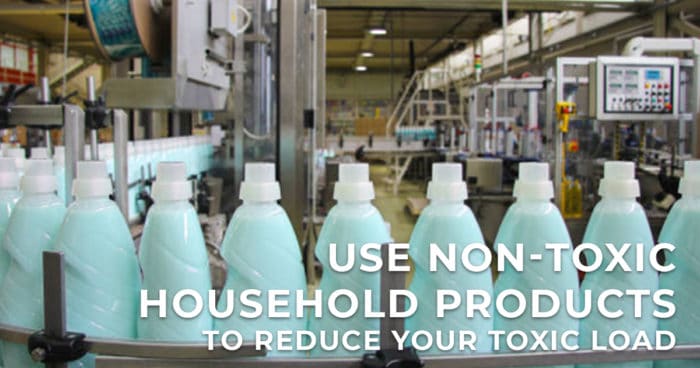
Reduce the toxic burden of your housekeeping products
So, you’ve thoroughly reduced the toxic burden of the things you’re applying to your body. It’s time to address what you’re applying to your home. This is my worst area when it comes to being mindful of toxins and I usually rely on Brad to remind me how important it is to consider the impact of the following on my overall toxic load.
Laundry soap and fabric softener.
As I mentioned in the deodorant section, my sweat is profuse and disgusting. While I’ve read lots of blogger chatter about soap nuts, baking soda and vinegar, I know in my heart is is no match for that powerful fragrance that can only be created when I take a hot yoga class. While I’d prefer to just burn everything after I wear it, I compromise on 7th generation free & clear detergent and am quite happy with it.
I’ve always been sensitive to fabric softener so Brad gave up his dreams of soft sheets and towels years ago. There are a few tricks I might employ to soften the linens on special occasions like his birthday or anniversary:
Nontoxic alternatives to fabric softener
- During the rinse cycle, add 1/2 cup of baking soda or vinegar to the wash. Since this isn’t a middle school science fair you don’t need to add both. I personally have more success with vinegar but I swear you can still faintly smell it even after drying.
- Add laundry balls or simple tennis balls to the dryer. These bounce around and beat your clothes into soft, pulpy submission. I actually find this method to work better than vinegar or baking soda, is cheaper in the long run, and easier for me to remember even with chemo brain.
Dish cleaner
Assume that you’re going to end up eating some dish cleaner no matter how thoroughly you rinse and consider the ingredients of your dish cleaner like you would a food item. Yeah, I know there aren’t a lot of options. Nevertheless, I can usually find something in the market that’s reasonable – Meyer’s or Seventh Generation are our usual go-tos. Dr. Bonner castile soap would also supposedly works but, as mentioned, I cant get it in Hong Kong.
Household cleaners
Oof. I like things clean. Really clean. I didn’t realize that I became dependent on poisonous chemicals to do my cleaning. Soft scrub with bleach, CLR… these were my best housekeeping pals. I was sad but determined when I threw them away.
I now follow three rules with my household cleaners:
- Use the least toxic cleaner you can. Start with dish soap and water. That should most of your cleaning tasks. White vinegar costs almost nothing and does an amazing job on tile, glass, and aluminum – just be sure to rinse it. For things like ovens and toilets, stick with the least toxic option that will do the job. If it’s not something you’d be comfortable ingesting, be sure you:
- Use gloves. If it gets on your skin its going to get into your body so protect yourself with a latex barrier.
- Use a mask. Even simple ammonia Windex and bleach give off fumes (and if you mix them, the resulting chlorine gas fumes can kill you outright). Wear a stylish bandanna and spend as little time as possible breathing in the area you just cleaned.
If you’re fighting an acute disease and need all your body’s immune resources focused on that, this is an area where having a caretaker, whether a spouse or close friend, can really help. If not, I’d rather have a dirty shower than stand in a cloud of CLR fumes.
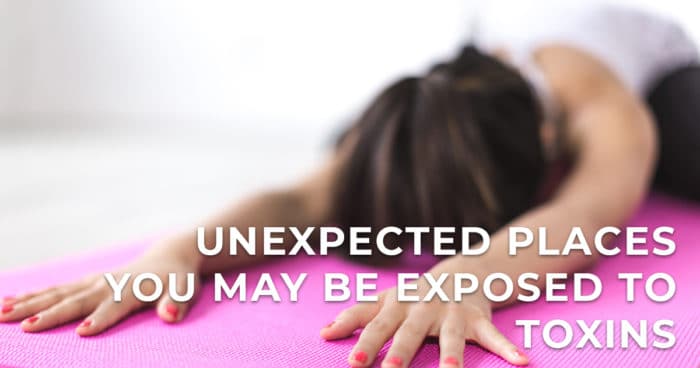
Bonus Points
The points above probably cover the majority of environmental contributors to your toxic burden. There are always surprises lurking outside to be aware of:
- Actually, this one is table stakes: DO NOT DRINK HOT LIQUIDS THROUGH PLASTIC! This includes a feeding tube, a straw, a bottle or a plastic coffee lid.
- Be aware of weird odors from cleaning products or construction at work. Be that person who asks about them and asks to move, if needed.
- Cheap goods. Have you ever ordered something from
ChinaAmazon that had a crazy chemical odor after you opened it? Did the instructions or reviews read that it just needs a day or two of “off-gassing?” Yeah, try not to be near that thing while it off-gasses. Or ever. - This was a crazy one for me but my yoga studio uses industrial scent diffusers in each room. Probably to mask my stinkiness (Farts During Yoga is my Cherokee name). I didn’t realize the risk until Brad pointed it out and now we always choose a mat on the opposite side of the room. And I bring my own mat cover to avoid the chemicals the studio uses to clean their mats. And I opt to shower at home with my own products. I’m such a weirdo.
- Privilege problems: I don’t trust the oils at the cheapo place I get my feet rubbed so I bring my own organic, unrefined coconut oil for them to use. I suspect they hate me.
There we are. I could honestly keep going but I’ll save the details for other posts. It amazes me that, in just the past 70 years our world has become this shockingly toxic. Even more amazing is that it’s so accepted, nay, expected. Don’t settle for being bathed in a world of toxins. Don’t immerse yourself in poison and expect your poor liver and kidneys to help you out. Do what you can to reduce their burden and you will be amazed by what your immune system can do when it’s not fighting everyday toxins.
* Note that not all “chemicals” are bad and not everything “natural” is good. Water, for example, is the chemical H2O and is very very good for us. Arsenic and cyanide both occur in nature. I’m talking more about what is meant to be in our body and what is not. Water should go in; polychlorinated biphenyls should not.


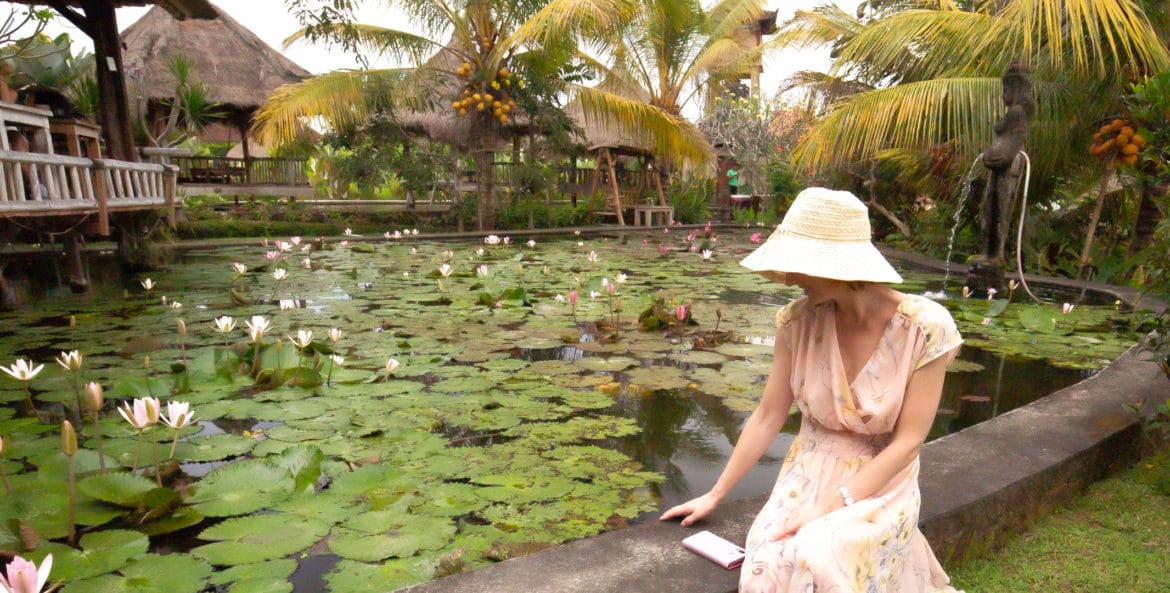
10 comments
Hi Maggie, an excellent read as usual! Such great information…thanks so much for doing all of the research and I will most definitely be keeping this list handy. Greetings from “lock down” in So. Baja!
You are always so kind! Thank you!
It’s a little weird to vomit 5k words into the void and I’m always so so grateful for feedback! I hope you’re safe and have everything you need down in Baja. I can’t wait to visit you and the studio one of these days.
So much love to you!
Great article! I base that on the research I’ve been doing for many years and you have included much of the essentials. I especially appreciate the discussion on makeup. I have just forwarded the link to my wife and my daughter. Thanks, again! My search: https://duckduckgo.com/?q=clean+fifteen+dirty+dozen+%22califlower%22&norw=1&t=ipad&ia=web
Thank you so much! this was such a helpful comment! You made me re-read the article and realize how many typos I have. I’ll clean it up soon thanks to you!
I also appreciate that you are paying attention to what the owners of our government are doing.
Thanks, John! As one of the owners of our government, I’m pretty darn disgusted in our performance when it comes to protecting people. Then again, it’s only since moving back to the US this year that I learned that thinking a government’s job is to protect its constituents makes me a socialist in America. That works for me. Just like public health care, nutrition guidelines that promote health, subsidized higher education, science serving truth rather than corporate profit, etc, work for every other developed nation in this world. Sorry for the rant, I’ll save it for the next documentary 😉 Thanks for being a reader!
Please share your moisturizer recipes with us : )
I would love to hear it also!
So sorry for the delay! I was locked out my my account for a bit. Still dealing with a hack.
The recipe is above – thanks for encouraging me to get on it =)
Yes! I need to!
I was melting 1 part shea butter with 1 part cacao butter with 1 part coconut oil and 1 part Jojoba oil – all organic. I kept a small amount in a glass tub for use and the rest in the fridge. So creamy and smooth!
I’m too lazy the days and just use unrefined organic Argan oil =)